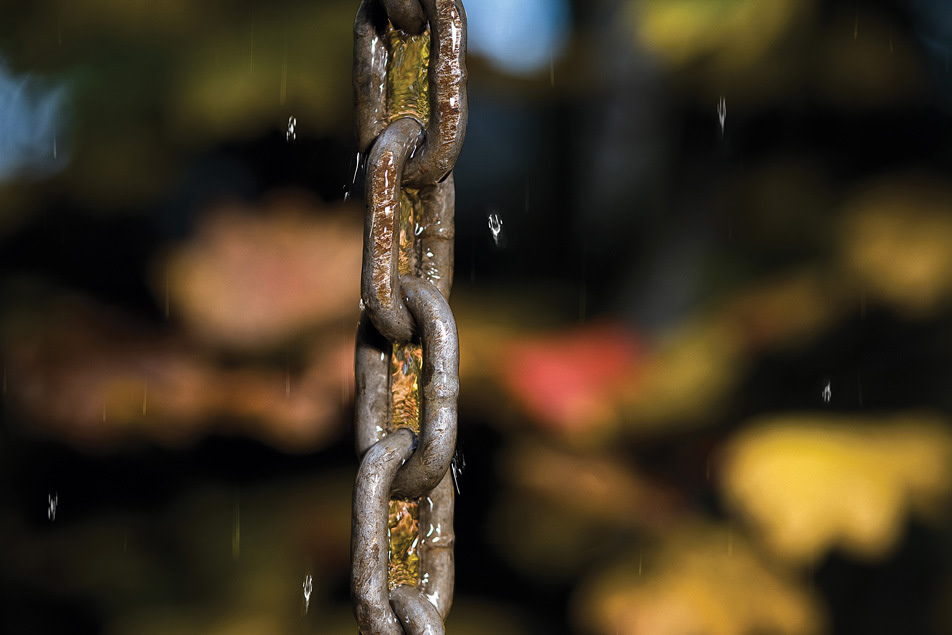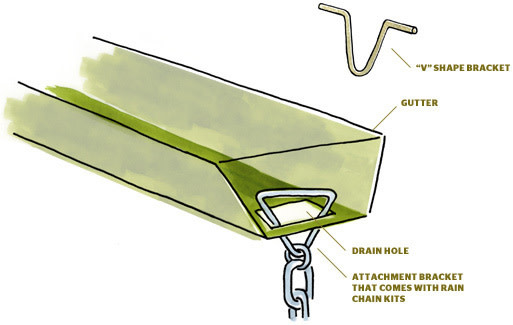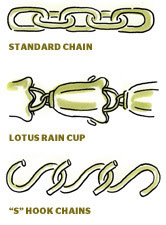Dynamic Downspouts

As a transplant to Oregon, I quickly learned to make peace with the falling rain. Far tougher was accepting what happens once it hits the ground. The roof of one 1,000-square-foot house can send up to 22,500 gallons of rainwater to the sewers each year via its downspouts, which funnel water to the storm drains in the street. Most Portland homes connect to a single set of pipes that mix clean rainwater with the waste from our hoses, sinks and toilets on the way to the treatment plant. On dry days, no problem. But virtually any measurable rainfall floods the system, sending a rich stew of rainwater and sewage into overflow pipes. Destination: the lower Willamette River.
Historically, Portland has dumped as much as six billion gallons of this muck per year into the city’s rivers. With the completion of the $306 million West Side CSO (combined sewer overflow) project in 2006 (better known as the “Big Pipe” project), we’re down to about 2.1 billion gallons per year. By 2011, $426 million of additional East Side pipe will cut the flush by 80 percent—down to a mere 400 million gallons each year.
But even if you find that much sewage in your local river acceptable, keep in mind that we, the taxpayers, are now bankrolling the unnecessary treatment of billions of gallons of rainwater from our homes’ downspouts—an urban surcharge every homeowner can help reduce with a simple, stylish addition: rain chains.
{page break}

How They Work
Rain chains were invented by the ancient Japanese to collect storm water for later use. They work in an almost magical way: Water slithers down the links from your roof to your yard, garden or collection barrel below. Typically made of copper, brass or aluminum, they range from simple chain-link styles to elaborately decorated cups, and they hang from your gutters in place of spouts.
The more surface area a chain has, the more rain it can handle. A single chain works well in light rains; two or three hung together work better in our denser deluges. But for those classic Portland bucket-dumps, the winner is the rain-cup chain, in which metal cups hanging vertically in a series empty the water, one into the next, to produce a pleasant babbling sound.
Installing Your New Chains
To get started, pick a downspout. Seeing and hearing the chain is important, but remember: While a tinkling chain is a pleasure to drink hot sake to, it can be Chinese water torture if you’re trying to fall asleep. You’ll also need to think about slope and drainage. Rainwater is best enjoyed when it drains away from your foundation.
Consider a front porch—the overhangs are usually large, and often there is no basement below. The chain is easy to see, inside and out.
Removing a downspout requires a screwdriver (for the metal screws); a ladder (to reach the highest ones); and an appreciation for how boring a square metal pipe really is.
Simply unscrew the downspouts from the top connection and install the bracket, which will hold the new chains. Off-the-shelf rain-chain kits come with one, but enterprising types can go homemade by bending a 12-inch steel rod (¼-inch diameter) into a “V” shape, keeping a few inches of the bar straight on each end. The straight pieces will sit on the inside of the gutter while the “V” protrudes downward through the drain hole, creating a place to hang the chains.
{page break}
Capture the Water
You’ll need to place something below the chains, either to help disperse the water or collect it for later use. A cairn of river rocks is simple to construct and helps prevent muddy splashing at the end of the chains. You can also create a drainage path leading the water to a garden or a cluster of moisture-loving ferns and reeds. And one easy solution is a classic rain barrel to save water for drier times. If you’d like to amplify the babbling, a large stone or metal bowl placed below a tinkling chain will produce some lovely, deeper water-music notes.
Diverting even a little water from the pipes makes a big impact, enough that the city will pay you to do it: $53 for every downspout you disconnect, if you’re in the current target area, plus a small sewer-bill discount based on the amount of storm water retained on your property. (Call 503-823-5858 for details.)
Where to Buy the Chains

Given our 36.3 inches of annual rainfall, the local selection of rain chains is surprisingly small. Smith & Hawken (smithandhawken.com) (26 NW 23rd Place) and Portland Nursery (portlandnursery.com) (two locations) carry both chain and copper cup styles for $45 to $109 each. Some chains give a nod to their Japanese origins in their shape: lotus flowers or lilies made of sculpted copper. Simpler, funnel-shaped cups have a geometric appearance that nicely melds traditional and modern aesthetics. If you enjoy a bit of whimsy, rainchains.com offers a design with small copper pineapples, the perfect touch for your Gilligan’s Island–themed garden.
A dearth of local choices is also a great reason to be inventive. W.C. Winks Hardware (200 SE Stark, winkshardware.com) offers simple steel chain, sold for $1.74 per foot, which will develop a patina over time. Or connect off-the-shelf, six-inch “S” hooks Barrel-of-Monkeys style—they’re as clever as they are fun to make. A quintessentially “Portland” solution might be to braid discarded tire chains into a stylish example of recycling. Drill holes through enameled camping cups, string them on cable like popcorn garland, and you might just start another local DIY cottage industry.
Helping the river has never been so beautiful. Loving the rain has never been so easy.
